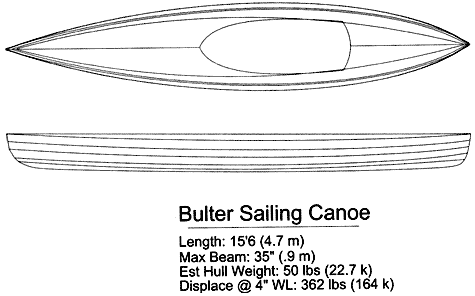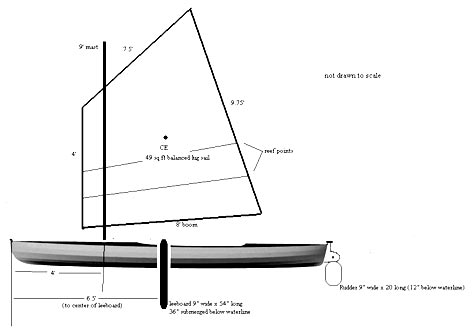Building a Modern Decked Sailing Canoe
by Jose Joven
In 2002 I came upon a copy of Todd Bradshaw’s “Canoe Rig: The Essence and the Art”. It is a beautiful book, well illustrated with colorful drawings of historically designed open sailing canoes. About the same time I found the writings of Hugh Horton, a sail canoe builder in the most modern sense. Hugh’s decked sailing canoes incorporate a commercially made graphite composite hull (Bell Starfire) with custom fabricated wood decks, graphite and Kevlar reinforcing and a Gunter sail. This looked like fun and being a dedicated canoeist I decided to more fully explore the art of canoe sailing.
Since I already owned three open canoes I decided to outfit them for sail. My first experiments were on a Souris River Quetico 16, a fine wilderness tripping tandem that in the end made a great sailer. I installed a mast step at the rear of the bow seat and my mast partner was a PVC “T” pipe connection which I lashed to the rear of the bow seat. I made a leeboard thwart and clamped it to the gunnels with 2” aluminum angle clamps. The original mast was a painter’s extension pole. My first sail was a small sprit made from blue polytarp. I decided to simply use a paddle for steering. “Old Blue” gave me many hours of enjoyment that first year, learning the rudiments of canoe sailing, how to tack, gibe, and run with the wind.
The next summer we planned a wilderness trip in Canada down the lower Missinaibi River. Though the first 100 kilometers are whitewater runs the last 220 line up with the prevailing winds and would be a good time to practice my sailing skills. I had to outfit my solo tripper (Mohawk Odyssey 14) with a rig that would be portable, lightweight, and yet efficient. I decided on a balanced lugsail made of Tyvek. Lightweight and tough, the Tyvek material proved perfect for the job. With modifications my carrying yoke doubled as a leeboard thwart and I made a bracket so that a spare paddle could be used as a leeboard. The mast, yard and boom were cut riverside after all the difficult rapids and portages were completed. . Again my paddle doubled as a steering oar. With this rig I sailed over 200 kilometers, all the way to the Indian villages of Moosonee and Moose Factory on James Bay. It was quite an adventure!

Sailing the Missinaibi River, 95K to James Bay
Another year brought more improvements and experiments. I tried the “Radio Flyer” rudder system, as outlined on a webpage for building a $50.00 sailing canoe. It worked fine, though I didn’t care for its unconventional appearance. I also wanted a decked canoe, like were popular in the 1800’s, the heyday of canoe sailing. I decided to build one using stitch and glue plywood panels.
Surfing the net I found JEM Watercraft, a stitch and glue canoe and kayak designer. I wrote Matt and asked if he could produce a set of panel drawings to my specifications. He replied positively and after several e-mails we firmed up a plan.

Matt left the sail and rig design up to me and I came up with this:

I had some ¼” Superply leftover from a construction project so that would be the hull. After receiving the plans from Matt I started to work laying out the panels. This was my first attempt at building a stitch and glue boat and I was amazed at how quickly the process moved along.

I’ll be updating you as the work progresses.

